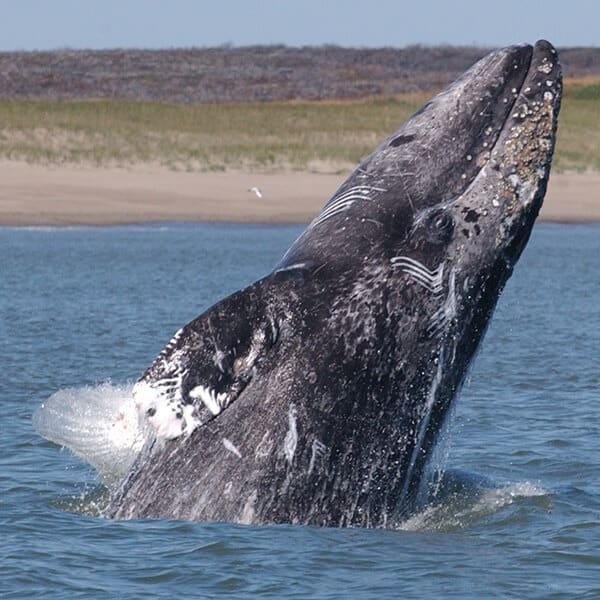Beacon’s Beach – Whale Watching Capital Of The World? Well, no, but you can see whales from the top of the bluff.
Video: Gray Whales Off Beacon’s Beach: Local drone footage on 12/11/18 of a grey whale breaching the surface at Beacons Beach in Encinitas California. Thanks to Nathan Minatta.
If you’re out on the ocean, you can look for flat patches on the water, which indicate that the whale is about to surface. You can also follow groups of birds diving for fish, which is a good indication that dolphins, sea lions, or even whales are probably feeding there, too.
What Is The Best Time To See Gray Whales In The San Diego Area? Winter is the best time to see pods of gray whales. Typically, from mid-December to mid-March to see more than 25,000 California gray whales migrating from chilly Alaskan waters south to warm waters in Baja, California.
A Whale By Any Other Name: The gray whale (Eschrichtius robustus), also known as the grey whale, gray back whale, Pacific gray whale, or California gray whale is a baleen whale that migrates between feeding and breeding grounds yearly. The common name of the whale comes from the gray patches and white mottling on its dark skin.
About Gray Whales: It reaches a length of up to 49 ft, a weight of 40 tons, and lives between 55 and 70 years.
The Pacific Ocean Gray Whales: Two Pacific Ocean populations are known to exist: A larger group with a population between 20,000 and 22,000 individuals in the eastern Pacific traveling between the waters off northernmost Alaska and Baja California Sur. Mothers make this journey accompanied by their calves, usually hugging the shore in shallow kelp beds, and fight viciously to protect their young if they are attacked. The western population has had a very slow growth rate despite heavy conservation action over the years, likely due to their very slow reproduction rate.
A second group of just 130 individuals with a migratory route exists near Russia and South Korea.
Thousands of people visit Point Reyes National Seashore every year to watch the passage of Pacific gray whales.
Guidelines for Whale Protection and Human Safety: For Hawaii, The Basic Guidelines – All ocean users (power boaters, sailors, jet skiers, kayakers, paddlers, windsurfers, swimmers, divers, etc.) must:
~ Keep a Safe Distance – Do not chase, closely approach, surround, swim with, or attempt to touch humpback whales.
~ Follow federal regulations that prohibit approaching (by any means) within 100 yards (90 m) when on or in the water, and 1,000 feet (300 m) when operating an aircraft. These regulations apply to all ocean users throughout the Hawaiian Islands.
Gray Whale Video From NOAA: Narration – “It is late spring on Kodiak Island, Alaska. The air and the water are growing warmer and the locals have returned to feed.
But even against this monumental landscape, all eyes are on the horizon for one of nature’s most graceful giants: the gray whale. It is here that they begin and end the longest migration of any mammal – 12,000 miles from the icy waters of the Arctic to the warm lagoons of Baja, Mexico, and back again.
Gray whales have a narrow, tapered head, and a streamlined body. They surface only for a quick spout and breath before disappearing back into the ocean.
Instead of teeth, gray whales have baleen, which is like a thick comb made up of long, fine hairs. Diving to the muddy bottom, grey whales scoop up sediment from the ocean floor, filtering out water and mud and trapping plankton and krill.
In the 1700 and 1800’s, whalers in search of oil, meat, and baleen hunted gray whales to near extinction. In 1946 an international treaty was signed to provide oversight and management of whale hunting. But it was under the protection of the Endangered Species Act in 1974, and NOAA’s careful management since, that the eastern Pacific gray whale recovered to a sustainable population.
Today, nearly 24,000 gray whales continue their annual migration along the coast of North America, giving humans a glimpse of these majestic creatures that live in the deep.”
